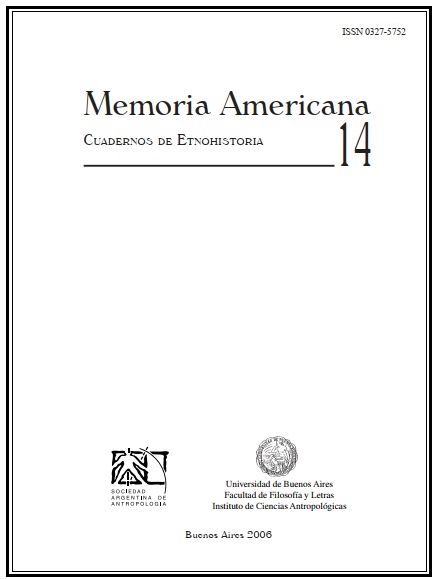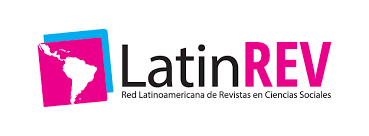Post-conquest images and ethnogenesis in the Quebrada de Humahuaca, Jujuy. Archaeological work hypotheses
Abstract
Currently, and from the standpoint of Archaeology, very little is known about the contact situation between indigenous and Hispanic people in Quebrada de Humahuaca. However the occasional mention of some objects blonging to the European material culture or their rock art, found mainly in indigenous pre-Hispanics sites is an exception. Based on contemporary research and study of collections and/or archaeological remains of the period embracing the first contact situations until the establishment of the colonial system in the region new hypothesis and archaeological interpretations appeared. This together with approaches coming from Andean History, Ethnohistory and Art History have opened new lines of research regarding objects identified as mobile art and the meaning of their representations according to specific contexts of use proposed by archaeological records and documentary sources.Downloads
References
Adanaqué Velásquez, Raúl 2000. Testamentos de caciques de Cajamarca: siglos XVII-XVIII. Uku Pacha, Revista de Investigaciones Históricas Año 1, Nº 2: 53:58. Lima, Ukupacha.
Bawden, Garth 2005. Ethnogenesis at Galindo, Perú. En Richard Martin Reycraft, (ed.); Us and them. Archaeology and ethnicity in the Andes. Monograph 53 Capítulo 2. Los Angeles, The Cotsen Institute of Archaeology, University of California.
Bordach, María Asunción; Osvaldo Mendoça; Marta Ruiz y María Ester 1998. El joven señor de La Falda: indicadores de una Persona Social en el Tilcara Hispanoindígena. En María Beatriz Cremonte, (comp.); Los desarrollos locales y sus territorios: 199-208. Jujuy, FHyCS, UNJu.
Bradley, Richard 2002. An archeology of natural places. Londres y New York, Routledge.
Bunster, Cora 2001. Las autoridades indígenas y los símbolos de prestigio. Andes. 12: 83-122. Salta, CEPIHA, UNSA.
Cremonte, María Beatríz; María Gabriela Ortiz y Alejandra Delgado 1997. Las vasijas en los estantes: clasificación de una colección cerámica descontextualizada. Cuadernos 9: 9-29. Jujuy, FHyCS, UNJu.
Cremonte, María Beatríz y Natalia Solís 1998. La cerámica del Pucará de Volcán: Variaciones locales y evidencias de interacción. En María Beatriz Cremonte (comp.); Los desarrollos locales y sus territorios: 155-178. Jujuy, FHyCS, UNJu.
Cummins, Tom 1991. We are the Other: Colonial Portraits of Kurakakuna. En Kenneth Andrien y Rolena Adorno (eds.); Transatlantic Encounters: 203-231. Berkeley, University of California Press.
Cummins, Tom 1994. Representation in the Sixteenth Century and the Colonial Image of the Inca. En Elizabeth Boone, y Walter Mignolo (eds.); Writing without Words: Alternative Literacies in Mesoamerica and the Andes: 189-219. Durham, Duke University Press.
Cummins, Tom 1998. Let me see! Reading is for them: colonial Andean image and objects “como es costumbre tener los caciques Señores”. En Elizabeth Boone, y Tom Cummins (eds.); Native traditions in the postconquest world: 91-148. Washington, Dumbarton Oaks.
D’Altroy, Terence 1993/98. Facciones y desarrollo político en los Andes Centrales. Xama 6-11: 79-111. Mendoza, INCHUSA, CRICYT.
Debenedetti, Salvador 1917/18. XIV Expedición Arqueológica de la Facultad de Filosofía y Letras. Libreta de viaje. Manuscrito.
De Egaña Antonius. S.J (ed) 1954. Monumenta Peruana Vol I (1565-1575). Roma, Soc Iesu.
Ferreiro, Juan Pablo 1999. Temporalia et aeterna. Apuntes sobre la muerte barroca en el Jujuy colonial del siglo XVII. Andes 10: 113-138. Salta, CEPIHA, UNAS.
Funari, Pedro 2001. La arqueología de las ciudades españolas y portuguesas en Sudamérica: una aproximación comparativa. NAYA http://www.naya.org.ar. Buenos Aires, Equipo Naya.
Garay de Fumagalli, Mercedes 1998. El Pucará de Volcán, historia ocupacional y patrón de instalación. En María Beatriz Cremonte (comp.); Los desarrollos locales y sus territorios:131-153. Jujuy, FHyCS, UNJu.
Gentile, Margarita 1988. Evidencias e hipótesis sobre los Atacamas en la Puna de Jujuy y Quebrada de Humahuaca. Journal de la Société des Americanistes 74: 87-103. París, Société des Américanistes.
Gentile, Margarita 1995. Análisis de algunos nombres de lugares del Noroeste Argentino a partir de su ubicación y de la historia regional prehispánica y colonial. Tawantinsuyu 1: 46-54. La Plata, Museo de La Plata.
Gisbert, Teresa 1980. Iconografía y mitos indígenas en el Arte. Bolivia, Gisbert y Cia. S. A.
González, Luis 2004. Bronces sin nombre. La metalugia prehispánica en el Noroeste Argentino. Buenos Aires, Ediciones FUNDACIÓN CEPPA (Centro de Estudios para Políticas Públicas Aplicadas).
Graña, Mario Julio 2001. La verdad asediada. Discursos de y para el poder. Escritura, institucionalización y élites indígenas sur andinas. Charcas. Siglo XVI. Andes 12: 123-137. Salta, CEPIHA, UNSA.
Guamán Poma de Ayala 1980 [c.1615]. Nueva Corónica y buen gobierno. Caracas, Biblioteca Ayacucho.
Hernández Llosas, Maria Isabel 1991. Modelo procesual acerca del sistema cultural humahuaca tardío y sus modificaciones ante el impacto invasor europeo. En Mercedes Podestá, María Isabel Hernández Llosas y Susana Renard (eds.); El arte rupestre en la arqueología contemporánea: 53-66. Buenos Aires.
Hernández Llosas, Maria Isabel 1998. Pintoscayoc: Arqueología de quebradas altas en Humahuaca. Tesis para optar al grado de doctor. Buenos Aires, Argentina. Facultad de Filosofía y Letras, UBA. Manuscrito.
Hernández Llosas, Maria Isabel 2001. Arte rupestre del Noroeste argentino. Origenes y contextos de producción. En Eduardo Berberián y Axel Nielsen (eds); Historia Argentina prehispánica, I: 389-446. Córdoba.
Hernández Llosas, Maria Isabel 2006 Inkas y españoles a la conquista simbólica del territorio de Humahuaca: sitio, motivos rupestres y apropiación cultural del paisaje. Boletín del Museo Chileno de Arte Precolombino.
Lagiglia, Humberto 1983. Primeros contactos hispano-indígenas de Mendoza (La arqueología histórica Argentina y su periodificación). En Eldo Morresi y Ramón Gutiérrez (eds); Presencia hispánica en la Arqueología Argentina: 191-201. Resistencia, Museo Regional de Antropología Juan A. Martinet, Instituto de Historia, Facultad de Humanidades, UNNE.
Loney, Helen 2000. Society and technological control: a critical review of models of technological change in ceramic studies. American Antiquity 65 (4): 646-668.
López, Mariel 2004. “El principio de un nuevo modo de ser andino. Propuesta transdisciplinar del estudio del contacto entre indios y españoles en la Quebrada de Humahuaca (siglos XVI y XVII)”. Proyecto de Beca postdoctoral CONICET (2004-2006). MS.
López, Mariel 2005a. ¿Iconografía Inka o colonial? De las representaciones simbólicas de lo incaico a las imágenes postconquista en la Quebrada de Humahuaca, Jujuy, Argentina. Una hipótesis de trabajo sobre representaciones figurativas en la cerámica “Inka Provincial” de los momentos de contacto hispano indígena [cd-rom]. En Actas del VI Congreso Internacional de Etnohistoria, 22 al 25 de noviembre. Buenos Aires.
López, Mariel 2005b. The first Hispano-Indigenous archaeological project in the Humahuaca Rift Valley, Argentina. Antiquity 79 (306), Proyect Gallery.
López, Mariel 2006a. Enfants Huaca. Sépultures en Ollas des enfants nés dans des circonstances spéciales selon les extirpateurs d’idolâtries andines du XVII ème siècle. ArchaeoPress. International Series. Oxford, British Archaeological Reports (BAR). En prensa.
López, Mariel 2006b. Otra vuelta de rollo a la tecnología cerámica en la Quebrada de Humahuaca, Provincia de Jujuy, República Argentina. Archaeopress, Serie Tesis doctorales. Oxford, British Archaeological Reports (BAR). En preparación.
López, Mariel 2006c. Persistencia o resistencia: los ritos libatorios en contextos fúnebres de la Quebrada de Humahuaca, República Argentina, El caso del sitio La Huerta, siglos 16 y 17. En preparación.
López, Mariel 2007. Complejidad social, especialización artesanal e innovaciones técnicas en Quebrada de Humahuaca: un caso de cerámica ¿Inka Provincial? arqueométricamente analizada. En María Beatriz Cremonte y Norma Ratto; Cerámicas arqueológicas. Perspectivas arqueométricas para su análisis e interpretación. Jujuy, EDUNJu. En prensa.
Lorandi, Ana María 1984. Pleito de Juan Ochoa de Zárate por la posesión de los indios Ocloyas. ¿Un caso de verticalidad étnica o un relicto de archipiélago estatal? Runa XIV: 123-141. Buenos Aires, MET, FFyL, UBA.
Lozano, Pedro. SJ. 1941 [1733]. Descripción corográfica del Gran Chaco Gualamba. Publicación Nº 288. Tucumán, Departamento de Investigaciones Regionales, Publicaciones especiales del Instituto de Antropología, Universidad Nacional de Tucumán.
Martínez Cereceda, José Luis 1995. Textos y palabras. Cuatro documentos del siglo XVI. En Ana María Presta (ed. y comp.); Espacio, etnías, frontera. Atenuaciones políticas en el sur del Tawantinsuyu. Siglos XV-XVIII: 251-284. Sucre, Ediciones ASUR.
Mendonça, Osvaldo; María Asunción Bordach y Margarita Grosso 2003. Ocupación territorial e intercambio en el período hispanoindígena. Estudio comparado de dos cementerios: RCH 21 (Catamarca) y SJTIL 43 (Jujuy). Cuadernos 20: 221-237. Jujuy, FHyCS, UNJu.
Nielsen, Axel 2005. Pobres Jefes: Aspectos Corporativos en las Formaciones Sociales Pre-Inkaicas de los Andes Circumpuneños. En Cristóbal Gnecco y Carl Langebaek (ed.); Contra el pensamiento tipológico: reflexiones teóricas actuales sobre complejidad social. Bogotá, Universidad de los Andes.
Ortiz, Gabriela y Alejandra Delgado 2002. Estilo y variabilidad cerámica intrarregional. Un caso de estudio en la Quebrada de Humahuaca. Estudios sociales del NOA 5: 136-178. Jujuy, IIT, FFyL, UBA.
Pauketat, Timothy 2001. Practice and history in archaeology. Anthropological Theory Vol I (1): 73-98. Londres, SAGE publicaciones.
Palma, Jorge 1998. Curacas y señores. Una visión de la sociedad política prehispánica en la Quebrada de Humahuaca. Jujuy, IIT, FFyL, UBA.
Penhos, Marta 2004. Las imágenes y los objetos religiosos en la incorporación del espacio americano al dominio blanco. El caso de la conquista del Chaco a fines del Período Colonial. En I Jornada de Estudios sobre Religiosidad, Cultura y Poder. Buenos Aires, GERE, PROHAL, Instituto Ravignani, FFyL, UBA.
Raffino, Rodolfo 1993. Inka. Arqueología, Historia y Urbanismo del Altiplano Andino. Buenos Aires, Ed. Corregidor.
Reycraft, Richard Martin (editor) 2005. Us and them. Archaeology and ethnicity in the Andes. Monograph 53. Los Angeles, The Cotsen Institute of Archaeology, University of California.
Rice, Prudence 1998. Contexts of contact and change: peripheries, frontiers, and boundaries. En James Cusick (edit.); Studies in culture contact. Interaction, culture, and archaeology: 44-66. Carbondale, Center for Archaeological Investigations, Southern Illinois University, Occasional Paper 25.
Rivolta, Maria Cristina y Axel Nielsen 1996-1998. La Falda: un cementerio hispano-indígena en Tilcara (Pcia. de Jujuy). Palimpsesto, Revista de Arqueología 5: 173-182. Buenos Aires.
Ruiz, Marta y Mariette Albeck 2005. Unkus en Rinconada [cd-rom]. En Actas del VI Congreso Internacional de Etnohistoria, 22 al 25 de noviembre. Buenos Aires.
Sánchez, Sandra y Gabriela Sica 1990. La frontera oriental de Humahuaca y sus relaciones con el Chaco
(1595-1650). Boletín del Instituto Francés de Estudios Andinos 19 (2): 469-497. Lima, IFEA.
Sánchez, Sandra y Gabriela Sica 1991. Algunas reflexiones acerca de los Tilcara. Avances en Arqueología 1: 82-99. Jujuy, IIT, FFyL, UBA.
Seldes, Alicia; José Burucúa; Marta Maier; Andrea Jáuregui, Gonzalo Abad y Gabriela Siracusano 1999. Blue pigments in South American Colonial Paintings. Journal of the American Institute of Conservation 38: 100-123.
Sica, Gabriela y Sandra Sánchez 1992. Testimonio de una sociedad en transición: el testamento de un curaca de Humahuaca. Cuadernos 3: 53-62. Jujuy, FHyCS, EDUNJu.
Siracusano, Gabriela 2005. El poder de los colores. De lo material a lo simbólico en las prácticas culturales andinas. Siglos XVI-XVIII. Buenos Aires, F.C.E.
Tarragó, Myriam 1984. El contacto Hispano-indígena: La provincia de Chicoana. RUNA 14: 145-186. Buenos Aires, MET, FFyL, UBA.
Tilley, Christopher 1994. A phenomenology of landscape. Places, paths and monuments. Londres, WBC Bookbinders.
Villagómez, Pedro 1919 [1649]. Exortaciones e instrucción acerca de las idolatrías de los Indios. En Colección de libros y documentos referentes a la Historia del Perú Tomo XII. Lima, Imprenta y Librería San Martí y CIA,
Zanolli, Carlos E. 1995a. En busca de los Omaguacas. Cuadernos 5: 37-48. Jujuy, FHyCS, EDUNJu.
Zanolli, Carlos E. 1995b. Omaguaca: la tierra y su gente. Presencia chicha hacia el sur de Talina. Siglo XVI. En Ana María Presta (ed. y comp.); Espacio, etnías, frontera. Atenuaciones políticas en el sur del Tawantinsuyu. Siglos XVXVIII: 319-344. Sucre, Ediciones ASUR.
Zanolli, Carlos E.2000. Hacia una reflexión sobre el poder, la identidad y las estrategias en una frontera del Tucumán. Memoria Americana 9: 157-174. Buenos Aires, FFyL, UBA.
Zanolli, Carlos E.2005. Tierra, encomienda e identidad: Omaguaca (1540-1638). Buenos Aires, S.A.A. Colección Tesis Doctorales.
Zanolli, Carlos E. y Ana María Lorandi 1996. Tributo y servicio personal en el Tucumán colonial. Memoria Americana 4: 91-104. Buenos Aires, FFyL, UBA.
Copyright (c) 2006 Memoria Americana. Cuadernos de Etnohistoria

This work is licensed under a Creative Commons Attribution-NonCommercial-ShareAlike 4.0 International License.
Los derechos de autor son cedidos a Memoria Americana. Cuadernos de Etnohistoria, no obstante los autores podrán recuperarlos y reproducir su trabajo en otros medios o formatos previo envío de solicitud al Comité Editorial. En tales casos, deberá citarse a Memoria Americana. Cuadernos de Etnohistoria como primera publicación del trabajo y el mismo queda bajo una licencia Creative Commons CC BY NC SA 3.0 Attribution- Non Commercial -ShareAlike 3.0, la cual provee libre acceso inmediato a sus contenidos pues se rige por el principio según el cual hacer disponible -en forma gratuita- la investigación al público fomenta un mayor intercambio de conocimiento a nivel global.
Los autores deberán remitir el siguiente formulario de cesión de derechos y compromiso de originalidad:
Cesión de derechos y compromiso de originalidad
Al Comité Editorial de Memoria Americana, Cuadernos de Etnohistoria
Por la presente declaro ser el autor del trabajo titulado (nombre del artículo), el mismo es original y propio y no ha sido publicado en ningún formato o soporte con anterioridad.
En caso de ser aceptado para su publicación en Memoria Americana. Cuadernos de Etnohistoria (número/año) cedo los derechos editoriales que me corresponden por el aludido artículo para su publicación en todos los formatos que posea la mencionada revista.
Si quisiera publicar este artículo a través de otro editor o en otro lugar me comprometo a solicitar el correspondiente permiso por escrito al Comité Editorial de Memoria Americana. Cuadernos de Etnohistoria. De ser afirmativa la respuesta del Comité Editorial me comprometo a lo siguiente:
- especificar lugar, editorial y fecha de la primera publicación del artículo en la nueva publicación
- realizar esta republicación sólo luego de transcurridos un año calendario desde la fecha de la presente nota de cesión de derechos
FIRMA
Aclaración











